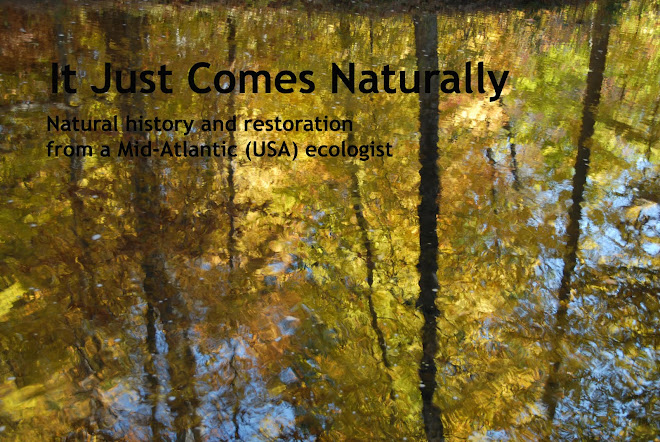For the last 22 springs, I have been censusing the birds nesting in a 40-acre forested section of my preserve. The censuses involve walking a rough path through the forest, stopping every 50 meters and then observing and listening quietly for 10 minutes to try to delineate breeding territories. I have to do this eight times over the course of the late spring (Cornell Laboratory of Ornithology protocol), and each individual census takes 3 hours and 10 minutes to complete, plus 15 minutes walking to the forest and 15 minutes back. I'm really glad when the last of the eight censuses is completed each year, since I have to awaken at 5 a.m. to get to the forest by sunup.
With two decades of observations under my belt, I've noticed a few trends, but nothing earth shattering or spectacular. For example, Red-eyed Vireos (Vireo olivaceous), one of the most common birds early in this series of surveys, have nearly disappeared, an observation that I attribute to the fact that the forest has gotten more mature and Red-eyed Vireos are birds of woodlands and young forests. I've also stopped observing Brown-headed Cowbirds (Molothrus ater)--a great thing, because cowbirds are nest parasites that lay their eggs in other birds' nests and allow the "other" birds to foster the aggressive cowbird chicks, usually at the expense of their own young.
This year, however, I noticed a real shift in the "redbirds," the Northern Cardinals and the Scarlet Tanagers. Cardinals are usually among the most common birds in the forest; 6-8 territories in the 40 acres is not uncommon. But this year, I only had two cardinal territories; I wonder what's up?
In contrast, I had three pairs of Scarlet Tanagers nesting in my forest, an area where I'm usually lucky to get one pair. It was really a treat to be greeted by their gravelly call from high in the treetops, and to be able to watch the males defend their territories. The Cornell Lab has estimated that 10% of all Scarlet Tanagers worldwide nest in Pennsylvania, so I'm glad that my preserve can provide them with some of the habitat they so desperately need. I hope that they're back again next year in even greater numbers.
 |
| Scarlet Tanager (Piranga olivacea) [image from Internet source] |
_____
 |
| Wood Thrush (Hyloxcichia mustelina) [image from Internet source] |
On the eighth census this year, completed on Sunday morning, June 16, "action" was limited at some of the listening points. (As the breeding season progresses, the woods tend to become increasingly quiet; birds have established their territories and it only takes an occasional foray to the edge of the territory to fend off one's neighbor, so the birds can concentrate more on raising their broods.) I always carry a pair of plant clippers with me to trim away the vegetation that constantly threatens to overwhelm the path, and I occasionally venture off the path to clip an errant Japanese honeysuckle vine that his twined up into an understory shrub or cut back an aggressive multiflora rose.
On this, my eighth census morning, I spotted a particularly large clump of flowering Japanese honeysuckle off the trail and so went over to clip the stem and unwind the vine from the spicebush plant. No sooner had I clipped the vine than I realized I'd made a horrible mistake--a pair of wood thrushes had secreted their nest under the sheltering umbrella of the honeysuckle. The birds flew off to the nearby bushes and scolded me harshly.
Once the honeysuckle dies, the leaves dry up, turn brown, and the whole umbrella-like protection disappears. I probably ruined this pair of birds' breeding for the season with one well-intentioned but misguided clip of an invasive plant. I'm still fretting over it.
On this, my eighth census morning, I spotted a particularly large clump of flowering Japanese honeysuckle off the trail and so went over to clip the stem and unwind the vine from the spicebush plant. No sooner had I clipped the vine than I realized I'd made a horrible mistake--a pair of wood thrushes had secreted their nest under the sheltering umbrella of the honeysuckle. The birds flew off to the nearby bushes and scolded me harshly.
Once the honeysuckle dies, the leaves dry up, turn brown, and the whole umbrella-like protection disappears. I probably ruined this pair of birds' breeding for the season with one well-intentioned but misguided clip of an invasive plant. I'm still fretting over it.







